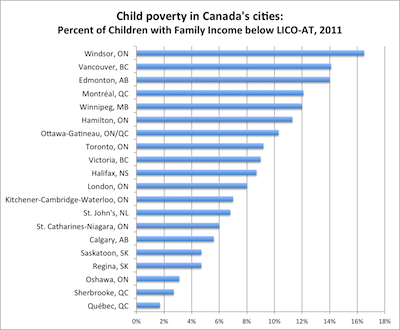New Living Wage Reports Force Us to Look at Child Poverty in the City
There reports released today show that the costs of supporting a family are rising fast in the three largest urban areas of our province, home to 2/3 of BC’s population. Two parents working full-time must each earn $20.10/hour in Metro Vancouver, $18.93/hour in Greater Victoria and $17.02/hour in the Fraser Valley.
The living wage reflects the actual costs of raising healthy children in our communities: local rent, child care fees, food and transportation costs. It provides for a basic level of economic security, but still represents a conservative, bare bones budget.
And when we look at the numbers, we find that the costs of the basics for families with kids is rising considerably faster than general inflation measured by the Consumer Price Index (CPI). This is true in all three communities calculating their living wage today.
In Metro Vancouver, for example, the living wage rose by 48c from $19.62 last year. This is an increase of 2.4%, well outpacing Vancouver’s inflation rate of 0.2%. The Greater Victoria living wage is up 1.1% from $18.73 last year, compared to Statistics Canada’s estimate of negative inflation in the city (-0.3% in 2013). And in the Fraser Valley, we’ve seen a jump of 65c or 4% over 2 years from $16.37 in 2012, much higher than BC’s inflation rate of 1% for that period.
The 2014 living wage numbers reveal a big gap between the low wages a number of British Columbians earn and the real costs of raising a family. Child poverty is a serious concern in our cities.
One out of every 10 children living in urban areas was poor in 2011 (9.9%), compared to one in 17 children living in non-urban areas (5.9%), based on Statistics Canada’s low income cut off after tax. Three quarters (or 74.4%) of all poor children in Canada lived in one of the 20 largest urban areas shown in the chart below.
Vancouver’s child poverty rates remains the second-highest in Canada and has actually seen an increase from last year’s 13.8% to 14.1%. Note that this is not just the City of Vancouver, but the entire metropolitan area, including municipalities from Anmore to Langley and Maple Ridge (complete list here).
Victoria is in the middle of the pack, in 9th place, with child poverty rate of 9%. These numbers refer to the Greater Victoria area (see here).
Child poverty isn’t a question of jobs: 6 of the 18 cities with lower child poverty rates than Vancouver experienced higher rates of unemployment in 2011. This is why it’s so important to talk about low wages and encourage employers to pay a living wage.
Windsor in Ontario had the highest child poverty rate of all Canadian cities (16.5% or one in every 6 children). Quebec City and Sherbrooke (both in Quebec) had the lowest urban child poverty rate in the country, less than 3%.
Statistics Canada reports on child poverty rates in selected municipalities with a total population of at least 100,000 (known to statisticians as census metropolitan areas). The data are updated every summer and can be found in CANSIM table 202-0802.
Topics: Children & youth, Employment & labour, Poverty, inequality & welfare


